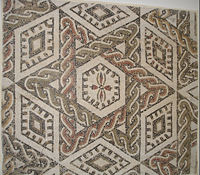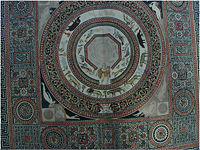Knots in traditional art
Jump to navigation
Jump to search
The representations of knots, or interlace patterns, in visual art had as its origin the art work of the late Roman empire[1]. These knot patterns appeared as a major motif in the third and fourth centuries AD, and can be seen in many surviving Roman floor mosaics of that time. Interesting developments followed in the artistic use of interlaced knot patterns in art traditions as diverse as Byzantine architecture and book illumination, Coptic art, Celtic art, Islamic art, Medieval Russian book illumination, Ethiopian art, and European architecture and book illumination.
Refrences
- ↑ James Trilling (2001). The Language of Ornament. Thames and Hudson Ltd ISBN 0-500-20343-1

